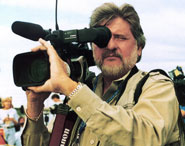|
|
Welcome to the March issue of The Digital Journalist, the monthly online publication for visual journalism.
There are few people who have not been touched by the depth of our recession. It is not unique to the United States, but is ravaging countries around the world. Thomas Friedman in The New York Times has called this period "The Great Disruption." What that means is our lives are undergoing a major shift and as a result hundreds of thousands of people are going to lose jobs and in many cases, their homes.
Anthony Suau proposed a story to Time magazine last year to cover the plight of residents of Cleveland, Ohio, who were losing their homes at a terrifying pace. Not only did he do the original assignment, but then returned a second time to complete the essay. This year, one of his photographs won the top award at the World Press Photo competition. Anthony has put together a special gallery for us of 39 images from his story, some of them never seen before. Anthony is responding to the tale of his time in the classic tradition of great photojournalists such as Gordon Parks, Carl Mydans, Dorothea Lange and Arthur Rothstein. We urge you to comment on his story and tell others about it.
Lauri Lyons is the first black woman photojournalist hired by Getty Images. She works in many genres as seen in our gallery of her photos and she has produced two books in her "Flag" series. Included in Ron Steinman's profile is a video about Lyons and her work, his introduction and a Q&A with this rising young photographer.
'Latitude' is the name of a new application created by Google that enables people to track other people through their cell phones. Ron Steinman worries about the issue of privacy for the unsuspecting and he sees little that is good in this new app.
We have three diverse and interesting Dispatches this month: Nick Moir's account of covering the deadly Australian wildfires with still images and video; Bernardo De Niz's report from China about that country's rapidly rising unemployment and its effects on the migrant population from the countryside, and Ilker Gurer's account of the return of Tartars to the Crimea after decades in forced exile.
Last year, Ken Kobre visited Nick Moir in Australia and did a 10-minute video of his work photographing fires. We include it in Dispatches.
E-Bits editor Beverly Spicer writes about the times we are in, ranging from astonishing scientific advances to scorched earth and homelessness, and the unlimited opportunities for visual journalists and social documentarians in this age.
Photographer David Burnett joins our staff this month as a contributing editor. Be sure to check out his new "We're Just Sayin'" column. David needs no introduction from us, other than our saying that he is unequivocally one of the most important photographers in the world. He is co-founder of Contact Press Images, and has helped develop the careers of many of the best photographers in the world. In his first column, he takes us back to where it all started, with Dr. Erich Salomon, the father of photojournalism.
Chuck Westfall has more Tech Tips; Mark Loundy exposes the Good, Bad and Ugly again in Common Cents, and Bill Pierce is, as always, on hand with his wonderful Nuts & Bolts. Also this month, Terry Heaton offers another thought-provoking Local Media in a Postmodern World column. Eileen Douglas reflects on the bane of a journalist's job – the slow day – in her Reporter's Life. And in Ethics, Karen Slattery and Mark Doremus explore the perils of "Pay For Play" for journalists who work for corporations with deep pockets.
In Assignment Sheet this month, retired Newsday staff photographer Dick Kraus talks about "Progress." Old-timers will shake their heads in agreement. Newbies will shake their heads in disbelief: "How did they do that?"
Finally, we have had a tragic death in our family. The Rocky Mountain News, one of the oldest papers in the country, finally ceased publication last month. According to its editor, John Temple, "It's crucial to note that newspapers across the country are being hit by a financial double whammy: a national economic meltdown and a dramatic shift in advertising spending. In Denver, the steep decline in classified advertising alone has meant the loss of more than $100 million in highly profitable categories like help wanted and real estate." The Rocky has distinguished itself by winning many Pulitzers, especially in photography. We have often called on them for major features. Janet Reeves, its Director of Photography, is about the best in the business. Unfortunately, this is just the beginning of the spiral we will see emerging in the months ahead as many newspapers find that publishing their print editions is no longer sustainable. Our heart goes out to all these noble people who are trying against all odds to honor our finest traditions.
We hope you enjoy this issue. Dirck Halstead |

